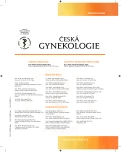Persistence of the treatment of overactive bladderin Czech Republic
Authors:
K. Švabík 1,3; J. Krhut 2,3; V. Finsterle 3; A. Martan 1,3
Authors‘ workplace:
Gynekologicko-porodnická klinika VFN a 1. LF UK, Praha, přednosta prof. MUDr. A. Martan, DrSc.
1; Urologická klinika FN, Ostrava, přednosta doc. MUDr. J. Krhut, Ph. D.
2; EUNI Inkoboard – www. euni. cz
3
Published in:
Ceska Gynekol 2013; 78(3): 252-256
Overview
Introduction:
Overactive bladder is chronic disease with high prevalence rate (9–42%). This syndrome requires longterm therapy but the persistence of this treatment in comparison with other chronic diseases as diabetes, hypertension, osteoporosis etc. is low. Accorging many studies the persistence variability is high and could be influenced by regional circumstanses. We desided to analyze real situation in parasympatolytics persitance in two years period in Czech Republic based on registry of health insurance company.
Methods:
We analyzed data between 2009 and 2010 of all clients of health insurance company where they fullfil their prescribtion. We analyzed the persistence in one year period in different periods of the year and within one year.
Results:
In comparison of the same period between those two year there was a trend of increase of prescription but it was not significant: 1306(SD 56.3) vs 1410 (SD 68.1) – p = 0.056. Prescription of the treatment after one year was only 18.5%(min. 16.8 – max. 20.4, SD 1.56). Major drop-out was in first 3-month period where renewed their prescription only 25.9% of the patients.
Conclusion:
This one of the first study analyzing the parasympatolytics prescription persistence based on registry of health insurence company. The persistence in Czech Republic was low but withing the range of international data. Those result should be used as a reference data for comparison of the effect of varius strategies influencing the overactive bladder treatment.
Keywords:
persistence – parasympatolytic treatment – overactive bladder
Sources
1. Benner, JS., Nichol, MB., Rovner, ES., et al. Patient-reported reasons for discontinuing overactive bladder medication. BJU Int, 2010, 105, p. 1276–1282.
2. Brubaker, L., Fanning, K., Goldberg, EL., et al. Predictors of discontinuing overactive bladder medications. BJU Int, 2010, 105, p. 1283–1290.
3. Haylen, BT., de Ridder, D., Freeman, RM., et al. International Urogynecological, and S. International Continence. An International Urogynecological Association (IUGA)/International Continence Society (ICS) joint report on the terminology for female pelvic floor dysfunction. Neurourol Urodyn, 2010, 29, p. 4–20.
4. Heidler, S., Mert, C., Temml, C., Madersbacher, S. The natural history of the overactive bladder syndrome in females: a long-term analysis of a health screening project. Neurourol Urodyn, 2011, 30, p. 1437–1441.
5. Kelleher, CJ., Cardozo, LD., Khullar, V., Salvatore, S. A medium-term analysis of the subjective efficacy of treatment for women with detrusor instability and low bladder compliance. Br J Obstet Gynaecol, 1997, 104, p. 988–993.
6. Martan, A., Horcicka, L., Hanus, T., et al. [Prevalence of women with overactive bladders in the Czech Republic]. Ces Gynek, 2011, 76, p. 144–150.
7. Sackett, DL. The hypertensive patient: 5. Compliance with therapy. Can Med Assoc J, 1979, 121, p. 259–261.
8. Sears, CL., Lewis, C., Noel, K., et al. Overactive bladder medication adherence when medication is free to patients. J Urol, 2010, 183, p. 1077–1081.
9. Sexton, CC., Notte, SM., Maroulis, C., et al. Persistence and adherence in the treatment of overactive bladder syndrome with anticholinergic therapy: a systematic review of the literature. Int J Clin Pract, 2011, 65, p. 567–585.
10. Vermeire, E., Hearnshaw, H., Van Royen, P., Dene-kens, J. Patient adherence to treatment: three decades of research. A comprehensive review. J Clin Pharm Ther, 2001, 26, p. 331–342.
11. Wagg, A., Compion, G., Fahey, A., Siddiqui, E. Persistence with prescribed antimuscarinic therapy for overactive bladder: a UK experience. BJU Int, 2012.
12. Yeaw, J., Benner, JS., Walt, JG., Sian, S., Smith, DB. Comparing adherence and persistence across 6 chronic medi-cation classes. J Manag Care Pharm, 2009, 15, p. 728–740.
Labels
Paediatric gynaecology Gynaecology and obstetrics Reproduction medicineArticle was published in
Czech Gynaecology

2013 Issue 3
Most read in this issue
- Intrahepatic cholestasis of pregnancy
- Determination of anti-Müllerian hormone in women
- Antibiotic profylaxis in obstetrics
- Peripartum cardiomyopathy after caesarean section – a case report
